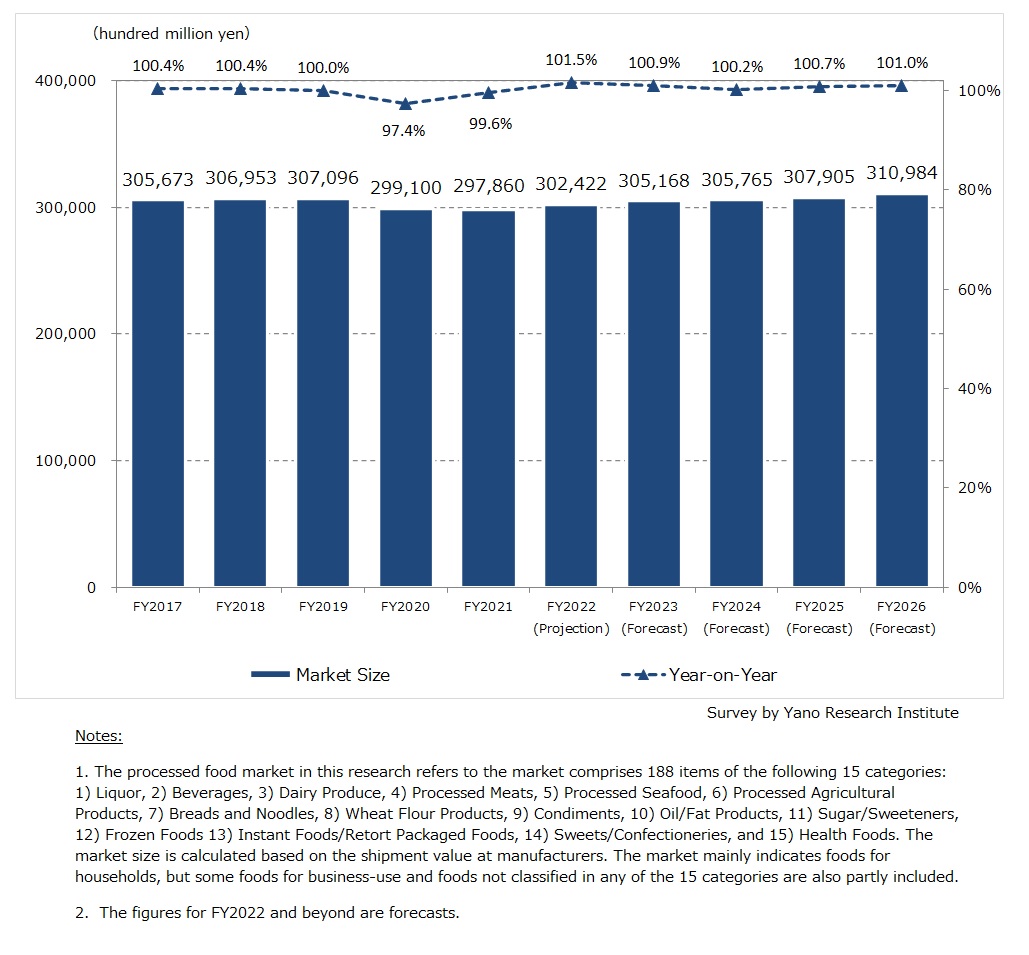No.3078
Processed Food Market in Japan: Key Research Findings 2022
Processed Food Market in Japan Shrank in FY2021 Chiefly Due to Demand Shock for Foods for Business-use in the COVID-19 Pandemic
Yano Research Institute (the President, Takashi Mizukoshi) has carried out a survey on the domestic processed food market and found out the transition and forecast of the market size, the trend by category/item, and future perspectives.

Market Overview
The domestic processed food market size fell to 29,786,000 million yen for FY2021, 99.6% of the size of the previous fiscal year, based on the shipment value at manufacturers.
Due to the prevalence of COVID-19, which led to shorter opening hours or closure of the stores and travel restrictions, items like liquor/beverages, foods for food services, thirst-quencher drinks for outdoor activities, and confectioneries for souvenir slumped in FY2020.
Meanwhile, as work from home became common and scattered the location of office workers, convenience stores that mainly operate in city centers struggled. As a result, sales of the items that rely on convenience stores as the strongest sales channel, such as handy snacks, chewing gums, and candies, declined. As food services did not recover to the pre-pandemic level, and sales of consumer processed foods made a downturn as a repercussion of public craze for stockpiling in the preceding fiscal year, the processed food market diminished marginally for FY2021.
Noteworthy Topics
Best-Selling Items & Market Drivers
Increase of health-conscious consumers has driven the demand for foods for health In the last couple of years. Significant demand is witnessed especially for the items featured on TV shows as health foods.
In the category of beverages, items that consumers can recognize as “healthy”, such as soy milk, Japanese tea drinks, vegetable juice, and yogurt drinks, are growing.
Soy milk has been selling well in particular, for it is valued for being high in protein, low in calories, and rich in soy isoflavone. Women that are highly conscious of their beauty have become loyal customers. Demand for soy milk has been rising among elderly people in the last couple of years, while it is also favored by men increasingly as a post-workout drink.
Having its health benefits affirmed, cheese is another driving force factor for the processed foods market. Sales of natto (fermented soybeans) has been expanding as well due to media coverage of its health benefits, which gave rise to consumer interest. Demand for natto has increased further by its recognition as "healthy food", owing to the scientific reports that evidenced fermented soy product contains "isoflavone" and "polyamine", the anti-aging substance, in addition to a type of protein called “AIM”, apoptosis inhibitor of macrophage, which may prevent development of cancer cells.
Trend of health-consciousness has boosted sales of sesame oil in the oil/fat market, and the trend of low carb diet and zero-carb diet attributed to the strong sales of low-calorie sweetener. Furthermore, as fermented pickles including kimchi have gained popularity as foods that enhance immune system, the pickles market expanded from the pre-pandemic period. Meanwhile, the launch of products that appeal “low salt” has been witnessed among all product categories, and some of them are selling quite well.
Viewing by components/functions, protein continues to gain traction as health foods, beauty foods, workout foods, immunity enhancement foods, and foods for prevention of Sarcopenia and frailty.
Gut health foods are also showing strong sales. As lactic acid bacterium is said to improve gut condition, relieving constipation or diarrhea, as well as strengthening immune system, yogurt drinks and cheese are selling well. The same can be said for natto, as natto bacteria is also helpful in improving gut health and enhance immunity. Makers are releasing quite a few products that appeal containing dietary fiber, as dietary fiber is also known for improving gut health.
Future Outlook
The domestic processed food market is forecasted to reach 31,984,000 million yen by FY2026. The expansion attributes to the recovery of food services, as well as to the rise in food prices.
In a medium- to long-term perspective, fast aging society and increase of small households (nuclear and single households) are expected to contribute to the stable market growth for health foods, foods for elderly people, foods in small portion, and pre-cooked foods (due to increasing demand for ‘convenience’ in preparing meals).
Research Outline
2.Research Object: Leading food manufacturers
3.Research Methogology: Face-to-face interviews by our expert researchers (including online interviews), survey via telephone and email, questionnaire, and literature research
Processed Food Market
The processed food market in this research refers to the market that comprises of 188 items of the following 15 categories: 1) Liquor, 2) Beverages, 3) Dairy Produce, 4) Processed Meats, 5) Processed Seafood, 6) Processed Agricultural Products, 7) Breads and Noodles, 8) Wheat Flour Products, 9) Condiments, 10) Oil/Fat Products, 11) Sugar/Sweeteners, 12) Frozen Foods 13) Instant Foods/Retort Packaged Foods, 14) Sweets/Confectioneries, and 15) Health Foods.
The market size of processed food is calculated based on the shipment value at manufacturers. The market consists mainly of food for households, but some foods for business-use and foods not classified in the 15 categories above are also partly included.
<Products and Services in the Market>
Liquor, Beverages, Dairy Produce, Processed Meats, Processed Seafood, Processed Agricultural Products, Breads and Noodles, Wheat Flour Products, Condiments, Oil/Fat Products, Sugar/Sweeteners, Frozen Foods Instant Foods/Retort Packaged Foods, Sweets/Confectioneries, Health Foods, and other kinds of foods
Published Report
Contact Us
The copyright and all other rights pertaining to this report belong to Yano Research Institute.
Please contact our PR team when quoting the report contents for the purpose other than media coverage.
Depending on the purpose of using our report, we may ask you to present your sentences for confirmation beforehand.